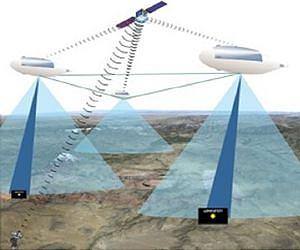 This illustration shows the Persistent UAVs networking, and collaborating with a satellite while providing video surveillance services. |
In the near future, payloads flying on Stratospheric UAVs will be far more relevant to such operations than will today's Conventional UAVs, even with similar payload capabilities.
This is one of the conclusions of a new "Stratospheric UAV Payloads - Markets and Technologies Forecast 2012-2021", available on ASDReports.com.
The new report examines, analyses and predicts the evolution of technologies, markets and outlays for the payloads that will serve aboard extremely enduring or persistent UAVs flying above the Jet Stream. While flying in the atmosphere, they will behave much like stationary satellites.
Today, persistence means maintaining a Predator orbit by replacing the on-station aircraft once or twice a day. That's a huge effort requiring at least three functioning aircraft and all their support.
They also risk giving away the operator's intent, a strong motivation to risk people hiding nearby rather than flying unmanned aircraft constantly. Conventional UAVs are hard to detect when flying very high, but certainly not impossible. Their presence over weeks to months will certainly be noticed.
Field of Regard or camera coverage area is another problem. Flying 20 - 30,000' above the ground, a camera can only be used over a relatively small footprint. Double that altitude and the footprint increases by a factor of four. In the illustration, you can see Persistent UAVs networking, and collaborating with a satellite while providing video surveillance services.
So, the next hunt for an elusive, very high value targets may benefit from Stratospheric UAV Payloads flying on the new Stratospheric UAVs being prototyped now. Those payloads will revolutionise the hunt by flying at twice Conventional UAV altitudes to see areas at least four times as large, all while being much harder to detect and remaining on-station for months or longer.






No comments:
Post a Comment